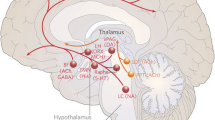Opinion statement
-
Sleep disorders commonly complicate the course following traumatic brain injury (TBI).
-
Insomnia, excessive daytime somnolence and alteration of the sleep-wake schedule are common disturbances that affect the course of recovery and prognosis in TBI survivors.
-
Few studies, however, have looked at the diagnosis and management of these disturbances in TBI. Early treatment of sleep disorders must be considered an integral part of the rehabilitation process. Recognition and management of comorbid medical or surgical diseases, assessment and treatment of associated psychiatric disorders, and awareness of other psychosocial stressors are mandatory steps in the management of sleep disturbances following TBI. In addition to pharmacologic therapy, nonpharmacologic approaches such as diet, environmental modification, and behavioral interventions are essential components in the management of sleep disturbances in TBI.
-
Based on the evidence that sleep disturbances impact rehabilitation in TBI patients we support the need for ongoing studies in this area.
Similar content being viewed by others
References and Recommended Reading
Roth T, Roehrs T: Sleep organization and regulation. Neurology 2000, 54(suppl):S2-S7. Good discussion on normal sleep architecture and regulation.
Rao V, Lyketsos C: Neuropsychiatric sequelae of traumatic brain injury. Psychosomatics 2000, 41:95–100.
McLean A, Dikmen S, Temkin NR, et al.: Psychosocial functioning at one month after head injury. Neurosurgery 1984, 14:393–399.
Keshavan MS, Channabasavanna SM, Reddy GN: Post-traumatic psychiatric disturbances: patterns and predictions of outcome. Br J Psychiatry 1981, 138:157–160.
Mahowald MW, Mahowald ML: Sleep disorders. In Head Injury and Postconcussive Syndrome. Edited by Rizzo M, Tranel D. New York: Churchill Livingstone; 1996:285–304. Review paper on sleep disturbances in TBI.
Kaplan HI, Saddock BJ: Normal sleep and sleep disorders. In Synopsis of Psychiatry. Edited by Kaplan HI, Saddock BJ. Baltimore: Williams and Wilkins; 1994:737–759.
Cohen M, Oksenberg A, Snir D, et al.: Temporally related changes of sleep complaints in traumatic brain injured patients. J Neurol Neurosurg Psychiatry 1992, 55:313–315.
Mann NR, Fichtenberg NL, Putnam SH, et al.: Sleep disorders among TBI survivors: a comparison study. Arch Phys Med Rehab 1997, 78:1055.
Fichtenberg NL, Millis SR, Mann RN, et al.: Factors associated with insomnia among post-acute traumatic brain injury survivors. Brain Injury 2000, 7:659–667. Investigates the relationship between insomnia and demographic/psychosocial variables.
Beetar JT, Guilmette TJ, Sparadeo FR: Sleep and pain complaints in symptomatic traumatic brain injury and neurologic populations. Arch Phys Med Rehab 1996, 77:1298–1302.
Guilleminault C, Yuen KM, Gulevich BA, et al.: Hypersomnia after head-neck trauma: a medico-legal trauma. Neurology 2000, 54:653–659. Describes a systematic approach in dealing with patients who complain of hypersomnia after head injury.
Quinto C, Gellido C, Chokroverty S, et al.: Posttraumatic delayed sleep phase syndrome. Neurology 2000, 54:250–252.
Patten SB, Lauderdale WM: Delayed sleep phase disorder after traumatic brain injury. J Am Acad Child Adolesc Psychiatry 1992, 31:100–102.
Schreiber S, Gur-Hartman T, Klag E, et al.: Polysomnographic and actigraphic findings of patients with traumatic brain injury [abstract]. J Neuropsychiatry Clin Neurosci 1997, 9:640.
Klein DC, Reppert SM, Moore RY: Suprachiasmatic nucleus: the mind’s clock. New York: Oxford University Press; 1991.
Zafonte RD, Mann NR, Fichtenberg NL: Sleep disturbance in traumatic brain injury: pharmacologic options. NeuroRehabilitation 1996, 7:189–195.
Vaughn MW: A psychiatric perspective on insomnia. J Clin Psychiatry 2001, 62(suppl):27–32.
Kaplan HI, Saddock BJ: Biological therapies. In Synopsis of Psychiatry. Baltimore: Williams and Wilkins; 1994:932–1127.
Chokroverty S: Diagnosis and treatment of sleep disorders caused by co-morbid disease. Neurology 2000, 54(suppl):S8-S15. Evaluation and management of sleep disturbances in patients with medical illnesses.
Wagner J, Wagner ML, Hening WA: Beyond benzodiazepines: alternative pharmacologic agents for the treatment of insomnia. Ann Pharmacother 1998, 32:680–691.
Damgen K, Luddens H: Zaleplon displays selectivity to recombinant GABAA-receptors different from zolpidem, zopiclone and benzodiazepines. Neuroscience Res Comm 1999, 25:139–148.
Greenbaltt DJ, Wright CE, von Moltke LL, et al.: Ketaconazole inhibition of triazolam and alprozolam clearance: differential kinetic and dynamic consequences. Clin Pharmacol Ther 1998, 64:237–247.
Dinan TG, Mobayed M: Treatment resistance depression after head injury: a preliminary study of amitriptyline response. Acta Psychiatr Scand 1992, 85:292–294.
Saran AS: Depression after minor closed head injury: role of dexamethasone suppression test and antidepressants. J Clin Psych 1985, 46:335–338.
Wroblewski BA, Joseph AL, Cornblatt RR: Antidepressant pharmacotherapy and the treatment of depression in patients with traumatic brain injury: a controlled prospective study. J Clin Psychiatry 1996, 57:582–587.
Cassidy JW: Fluoxetine: a new serotonergically active antidepressant. J Head Trauma Rehab 1989, 4:67–69.
Fann JR, Uomoto JM, Katon WJ: Sertraline in the treatment of major depression following traumatic brain injury. J Neuropsych Clin Neurosci 2000, 12:226–232.
Zasler ND: Advances in neuropharmacological rehabilitation for brain dysfunction. Brain Inj 1992, 6:1–14.
Feeney D, Gonzales A, Law W: Amphetamine, haloperidol and experience interact to affect rate of recovery after motor cortex injury. Science 1982, 217:855–857.
Schreiber S, Klag E, Gross Y, et al.: Beneficial effect of risperidone on sleep disturbance and psychosis following traumatic brain injury. Int Clin Psychopharmacol 1998, 13:273–275. Efficacy of risperidone in the treatment of sleep problems and psychosis.
Mellick GA, Mellick LB: Reflex sympathetic dystrophy treated with gabapentin. Arch Phys Med Rehab 1997, 78:98–105.
Rao ML, Clarenbach P, Vahlensieck M, et al.: Gabapentin augments whole blood serotonin in healthy young mem. J Neural Transm 1988, 73:129–134.
Evans RW, Gualtieri CT, Patterson D: Treatment of chronic closed head injury with psychostimulant drugs: a controlled case study and an appropriate evaluation procedure. J Nerv Ment Dis 1987, 175:106–110.
Morin CM, Culbert JP, Schwartz SM: Nonpharmacologic interventions for insomnia: a meta-analysis of treatment efficiency. Am J Psychiatry 1994, 151:1172–1180.
Guilleminault C, McCann CC, Quera-Salva M, et al.: Light therapy as treatment of dyschronosis in brain impaired children. Eur J Pediatr 1993, 152:754–759.
Richardson GS, Roth T: Future directions in the management of insomnia. J Clin Psychiatry 2001, 62(suppl):39–45. Discussion on emerging therapies in the evaluation and management of insomnia.
Author information
Authors and Affiliations
Rights and permissions
About this article
Cite this article
Rao, V., Rollings, P. Sleep disturbances following traumatic brain injury. Curr Treat Options Neurol 4, 77–87 (2002). https://doi.org/10.1007/s11940-002-0006-4
Issue Date:
DOI: https://doi.org/10.1007/s11940-002-0006-4




